Mixin It Up: Picking The Right Problem to Solve

A couple of days ago I posted about my new Loggable mixin, which makes it easy to inject an external logger into your Typescript classes at runtime.
I had a date with a pretty girl that night and was in a bit of a hurry to get the thing posted, so it wasn’t until the next day when I was preparing to release the related Batchable mixin that I realized I had a problem.
One of the things I love about Typescript is that it is very easy to close the gap between good code and self-documenting code.
Sounds deep, right? So what does that actually mean?
TL/DR: Facing a really thorny problem? Sometimes it just means you’ve thrown yourself into a briar patch.
This article turned out to be the second of a three-part series! Here they are in sequence:
- Loggable: A TypeScript Mixin for Generic Class Logging
- Mixin It Up: Picking the Right Problem to Solve (you are here)
- Composition in Action: Finishing the Swing
What is Good Code?
Well, clearly, at a minimum good code fulfills requirements: it does what it was meant to do.
But every grown-up developer knows there is more to it than that. Really good code is more than just a dropped plate of spaghetti that happens to stick to the wall. It also meets a coherent set of engineering principles, like:
- SOLID - Single Responsibility, Open/Closed, Liskov Substitution, Interface Segregation, Dependency Inversion
- DRY - Don’t Repeat Yourself
- KISS - Keep It Simple, Stupid
- YAGNI - You Ain’t Gonna Need It (so don’t write it)
- Law of Demeter - Only talk to your immediate friends
- Composition over Inheritance - Prefer composition to inheritance
Good code encapsulates the understanding that the work is not done: my good code will eventually have to talk to your good code, and it behooves us both to make that conversation as easy as possible.
What is Self-Documenting Code?
The trivially naive view of self-documenting code is that it is code so clear and well-organized that it doesn’t need comments.
Pro tip: adhering strictly to this view is a great way to get yourself fired. Especially by me.
In the real world we all use advanced IDEs like Visual Studio Code, which do neat things like show you a snippet of useful documentation when you’re about to invoke a function. Partly that happens automagically thanks to type inference (unless you’re using Javascript, in which case 🤷♂️), but many of the more useful bits (like what is this parameter actually for) only show up because you put them there on purpose.
In Typescript, this means you took the trouble to document your code with structured TSDoc comments. In Javascript, you took a lot more trouble to do the same thing with JSDoc. Either way, your code doesn’t just speak to other developers. It speaks to your tools.
Here’s an example, an interface declaration from Loggable tarted up with TSDoc:
/**
* Loggable options.
*/
export interface LoggableOptions {
/** Identifies logger endpoints disabled when `enableAll !== true`. */
disabled: string[];
/** Enables all logger endpoints when `true`. */
enableAll: boolean;
}
Here’s what I see when I hover over one of those properties elsewhere in my code:

So far, par for the course.
But the beauty of living here in the future is that, you’ve taken the trouble to make your documentation accessible to your tools, your options are only limited by your tools… and your toolbox is expanding by the day!
For example, all of my Typescript projects use TypeDoc, which can read my TSDoc comments and automagically generate API documentation for my project. Here’s the page generated by the interface declaration above:
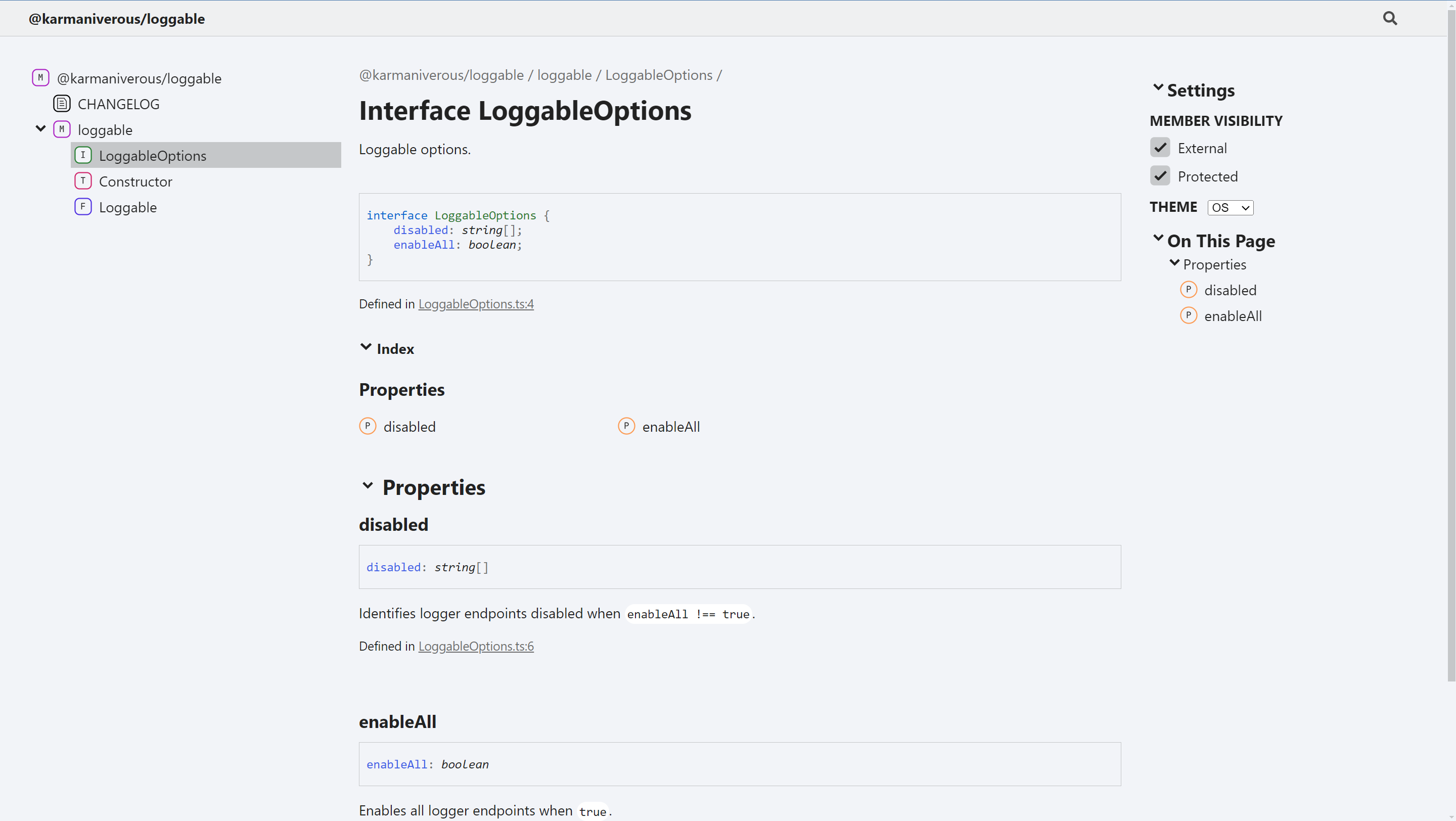
So with regard to the naive view proposed above: of course your code should be well-organized and clear. That doesn’t mean you should skip the comments. It just means that your comments should be attached to something worth documenting.
Self-documenting code, on the other hand, is another animal entirely.
Self-documenting code is code that can participate actively in its own documentation!
Now that is deep.
A Brief Detour into Mixins
If you recall, we started this conversation because I ran into some documentation-related problem with my Batchable mixin implementation. But wait… what exactly is a mixin?
Before we dig into the actual problem, let’s take a moment to understand the distinction between a mixin and a class.
A Typescript class is a way to encapsulate a complex set of behaviors and data into a single, reusable unit. The Typescript version adheres pretty faithfully to the Object-Oriented Programming (OOP) paradigm, with the caveat that “class” inheritance in Typescript is really prototype-based.
Compared to a more “pure” OOP language like Ruby or (shaddap haters) C++, a key constraint imposed by Typescript’s prototype-inheritance model is single inheritance. This means that a class can only inherit from one other class, as opposed to the multiple inheritance allowed in those other languages.
For example, let’s say I have a Loggable class that knows how to log to an external logging system, and a Batchable class that knows how to batch & throttle data operations against an API. In a pure OOP language like Ruby, I could create an EntityManager class that inherits from both Loggable and Batchable, and get the combined functionality of both.
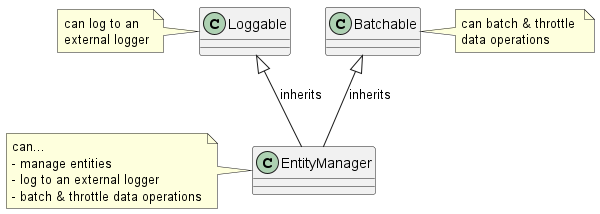
In Typescript, I can’t do that. I can only inherit from a single class, so I have to find some way to…
-
Preserve the useful isolation of distinct packages of functionality into the
LoggableandBatchableclasses. -
Combine them into a single class that
EntityManagercan inherit.
This is where mixins come in.
A mixin is a function that takes a class as an argument and returns a new class that combines the functionality of the original class with the functionality of the mixin. In the degenerate case, a mixin takes an empty class as its argument and returns a new class that exhibits only the mixin functionality.
Here’s what the same scenario looks like using mixins instead of multiple inheritance:
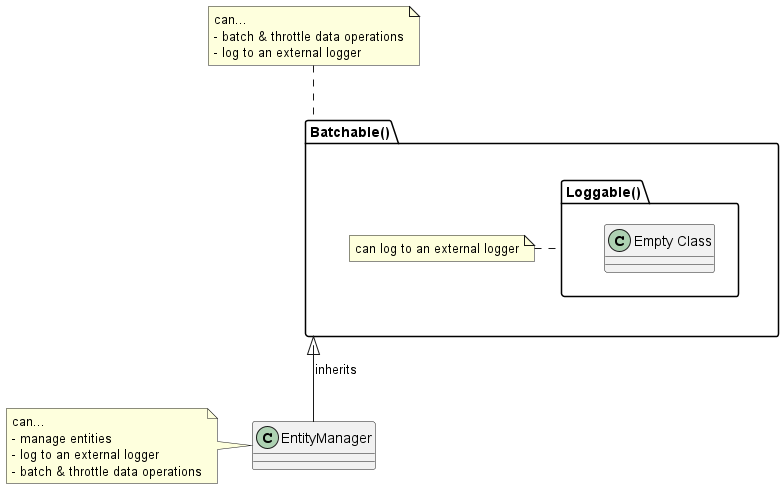
The salient point here is that when I made the decision to implement Loggable and Batchable as mixins, the things that I published were no longer classes, but functions.
The Problem
We’ve already established that tools like TypeDoc can activate the capacity of self-documenting code to do really useful things like automagically generate complex API documentation.
Could I do this by hand? Sure… but it’s such a pain that I probably wouldn’t bother. And even if I did, I’d only do it once. As soon as I made a change to the code, the documentation would be out of sync, and the cost of keeping the documentation in sync with the code would be so high that I wouldn’t do it for long.
This prompts an observation so obvious that it’s easy to overlook: the most valuable tools come with a built-in set of constraints. In other words, the more I like what TypeDoc does with my code, more important it is to stick to code TypeDoc can actually digest.
So what’s the problem?
To make any use of a Typescript class, I need to know a great deal about its internal structure. Therefore, TypeDoc takes great pains to document the properties, methods, and types related to any class.
For example, here’s the top of the EntityManager class page generated by TypeDoc:
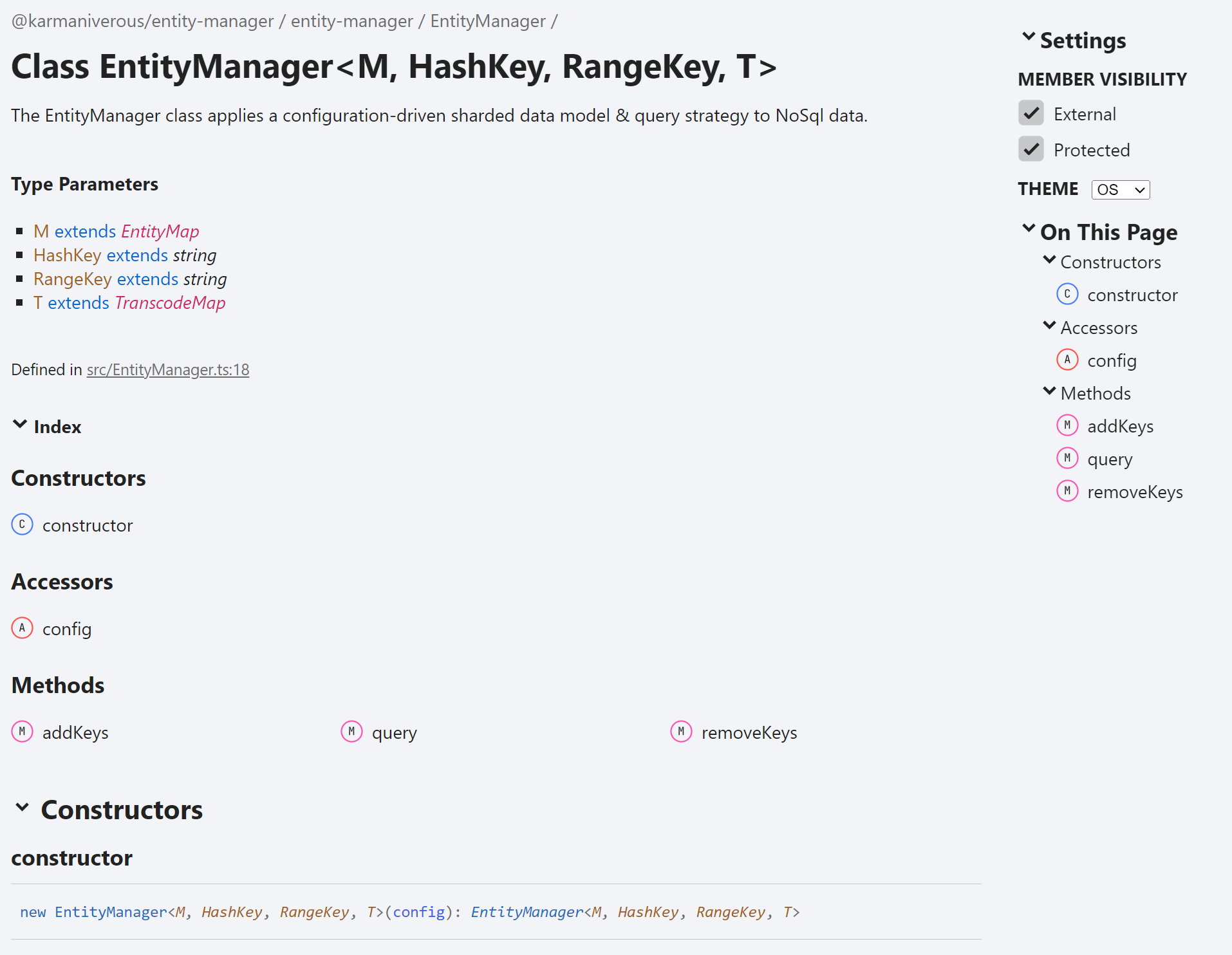
EntityManager class.
But a mixin is not a class. It’s a function that returns a class. And TypeDoc treats functions very differently: you get the function signature and any extra documentation you might have added at the top of the function, but that’s it.
Period.
Here’s the top of the current Loggable mixin function page generated by TypeDoc:
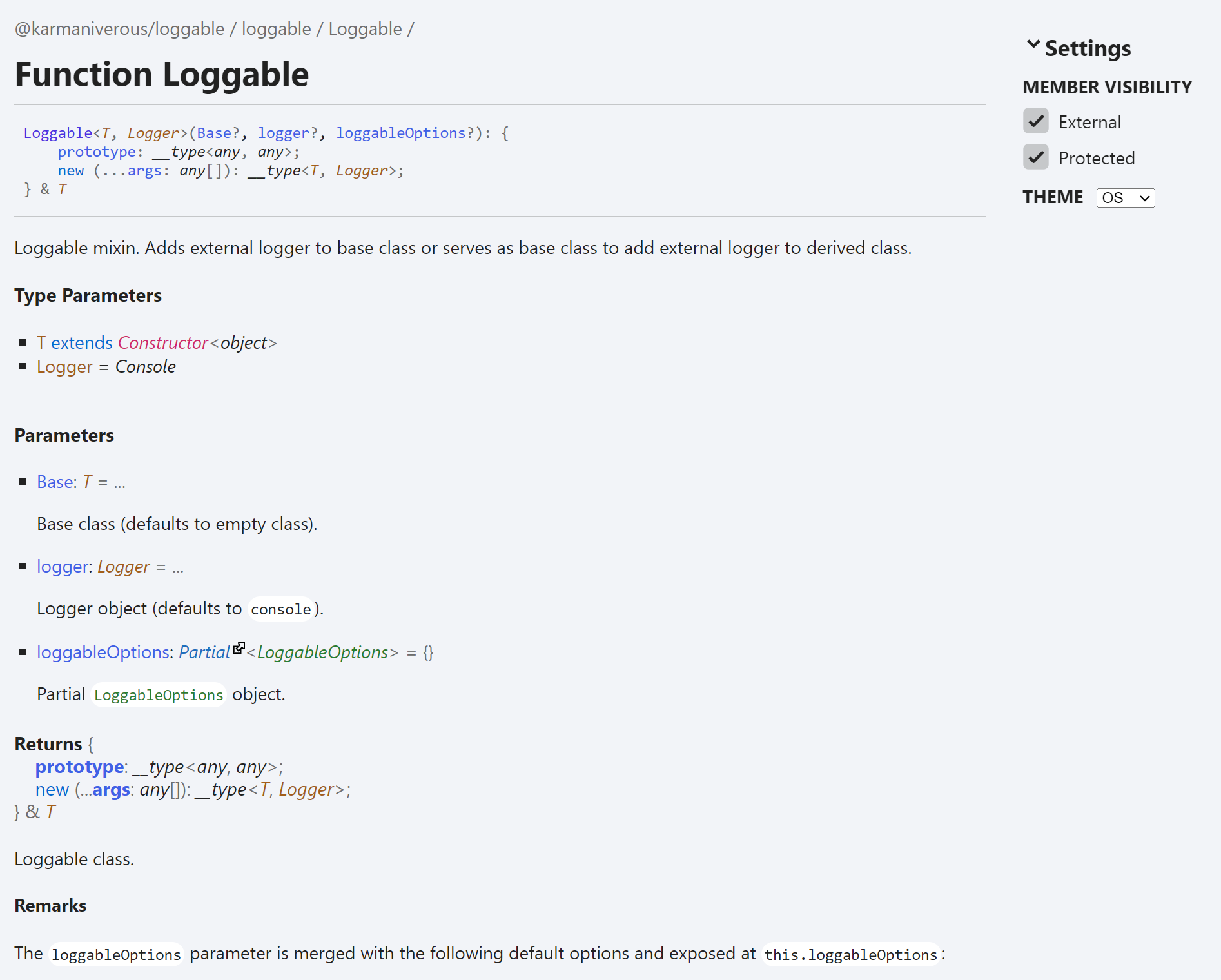
Loggable mixin function.
Half of what the user actually cares about is completely missing: the logger and loggableOptions properties generated on the Base class by the mixin. Without this information, the documentation is incomplete and the mixin is effectively useless to anybody but yours truly.
So, mixins… sweet implementation pattern, for sure. But given a mixin’s dual nature as both a function and a class, how can we make sure that the documentation generated by TypeDoc is complete?
The Problem Behind the Problem
So far, I’ve presented this problem from a very particular perspective: I have good reasons to do an advanced thing and am running up against the constraints of my toolbox.
But way up at the top of this article, we articulated a list of engineering principles that good code should adhere to. And one of those principles was Composition over Inheritance.
Ring a bell?
Recall that the entire topic of mixins is only relevant because I wanted to overcome Typescript’s multiple-inheritance constraint and inherit functionality in a single class from both Loggable and Batchable. Mixins are definitely one answer… but, as the discussion above shows, they bring their own set of problems along for the ride.
So what if we shouldn’t even be having this discussion?
What if core engineering principles really matter? In that case, the compounding difficulties imposed by the mixin solution aren’t just a deeper set of problems to be solved. They’re a design smell, and stand as clear evidence that I’m barking up the wrong tree!
Mixins solve an inheritance problem. If I can figure out how to convert my inheritance problem into a composition problem, I won’t have solved my mixin documentation problem…
I’ll have eliminated it.
The Composition Solution
If extreme difficulty can be a sign that you’re on the wrong track, then what about the reverse?
Watch this:
-
The
Loggablemixin generates a class with theloggableOptionsandloggerproperties. So rip the class out of its mixin function and publish it as a standalone class. -
The
Batchablemixin generates a class with thebatchableOptionsproperty and theprocessBatchmethod. So rip the class out of the mixin function and publish it as a standalone class. -
Pass an instance of each class as a constructor argument, store it as an instance property, and reference it on any class where it’s needed.
-
TypeDoc will document the properties and methods of the
LoggableandBatchableclasses as it would any other class. Nothing to see here, move along.
That’s it. That’s the whole solution.
Here’s what the combined implementation looks like now:

… at least it will once I’ve finished pushing things around this week.
Cue The Music
So what’s the takeaway here?
Sometimes, when you’re tangled up in a thorny problem, solving it is exactly the wrong answer.
Instead, take a step back and ask yourself if you’re even solving the right problem.
By revisiting core engineering principles like Composition over Inheritance, we can eliminate unnecessary complexity and arrive at cleaner, more maintainable solutions.
In other words, instead of hacking your way through the briar patch, spread your wings and fly!








Leave a comment